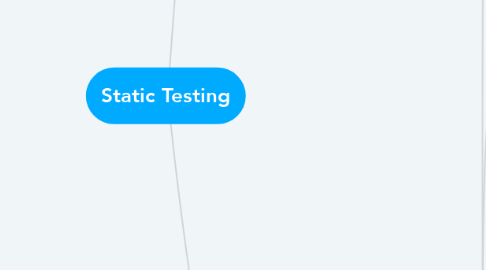
1. Static Testing Basics
1.1. Work Products that Can Be Examined by Static Testing
1.1.1. Specifications,
1.1.2. Epics, user stories and acceptance criteria
1.1.3. Architecture and design specifications
1.1.4. code
1.1.5. Testware, including test plans, test cases, test procedures, and automated test scripts
1.1.6. user guides
1.1.7. web pages
1.1.8. Contracts, project plans, schedules, and budget planning
1.1.9. Configuration set up and infrastructure set up
1.1.10. Models, such as activity diagrams
1.2. Benefits of Static Testing
1.2.1. static testing enables the early detection of defects before dynamic testing is performed
1.2.2. Detecting and correcting defects more efficiently, and prior to dynamic test execution
1.2.3. Identifying defects which are not easily found by dynamic testing
1.2.4. Preventing defects in design or coding
1.2.5. Increasing development productivity (e.g., due to improved design, more maintainable code)
1.2.6. Reducing development time & cost
1.2.7. Reducing total cost of quality over the software’s lifetime, due to fewer failures later
1.2.8. Improving communication between team members in reviews
1.3. Differences between Static and Dynamic Testing
1.3.1. Both have same objective which is assessment of the quality of the work products and identifying defects as early as possible
1.3.2. static testing finds defects in work products directly rather than identifying failures caused by defects when the software is run.
1.3.3. static testing can be used to improve the consistency and internal quality of work products, while dynamic testing typically focuses on externally visible behaviors.
2. Review Process
2.1. Work Product Review Process Activities
2.1.1. Planning
2.1.2. Initiate review
2.1.3. Individual review
2.1.4. Issue communication and analysis
2.1.5. Fixing & reporting
2.2. Roles and responsibilities in a formal review
2.2.1. Author
2.2.2. Management
2.2.3. Facilitator (often called moderator)
2.2.4. Review leader
2.2.5. Reviewer
2.2.6. Scribe (or recorder)
2.3. Review Types
2.3.1. Informal review (e.g., buddy check, pairing, pair review)
2.3.2. Walkthrough
2.3.3. Technical review
2.3.4. Inspection
2.4. Review Techniques
2.4.1. Ad hoc
2.4.2. Checklist-based
2.4.3. Scenarios and dry runs
2.4.4. Perspective-based
2.4.5. Role-based
2.5. Success Factors for Reviews
2.5.1. Each review has clear objectives
2.5.2. Review types are applied which are suitable to achieve the objectives
2.5.3. Any review techniques used, such as checklist-based or role-based reviewing, are suitable for effective defect identification in the work product to be reviewed
2.5.4. Any checklists used address the main risks and are up to date
2.5.5. Large documents are written and reviewed in small chunks
2.5.6. Participants have adequate time to prepare
2.5.7. Reviews are scheduled with adequate notice
2.5.8. Management supports the review proces
2.5.9. Reviews are integrated in the company's quality and/or test policies.
